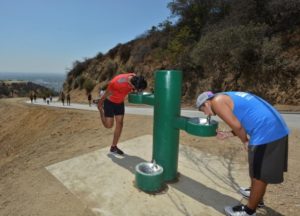
The Great Comeback of the Public Drinking Water Fountain
By Albert Rodriguez
Long revered as a symbol of health, civic pride and a champion of public space, the urban drinking water fountain has seen tough times in recent years. The advent and saturation of single-use plastic water bottles and sugary drinks has denigrated the once noble water fountain to a weathered, barely functioning object of curiosity in parks and schools.
Today, all that is changing, as LADWP moves forward with a multi-faceted initiative to make Los Angeles one of the most sustainable cities in the world. LADWP plans to install or refurbish 200 drinking water fountains, more recently referred to as hydration stations, citywide by 2035 for the enjoyment and health of all residents and visitors in the city. LADWP will partner with the City’s Department of Recreation and Parks and Department of General Services to install, refurbish and maintain the hydration stations.
L.A.’s Tap Water, by the Numbers
1 state-of-the-art filtration plant
2 aqueducts
84 pump stations,
118 tanks and reservoirs,
328 pressure regulator and relief stations (controls water pressure)
560 miles of trunklines (pipes greater than 20 inches in diameter)
6,780 miles of distribution mainlines (20 inches in diameter or less)
120,000 water quality tests performed on samples taken throughout the city!
This concerted effort to increase access to clean drinking water and decrease reliance on single-use plastic water bottles is one way LADWP can promote a more sustainable, healthier future for customers and the communities it serves. Nearly 50 million plastic water bottles are purchased and discarded every year across the U.S. with only 30 percent getting recycled. This is in addition to the environmental impacts created and the resources used to manufacture, package, and distribute these bottles.
It is only fitting that a world-class city like Los Angeles promote its drinking water and public hydration stations in much the same way that Rome, Tokyo or Paris does. Locals in those cities use their nasonis, mizu nomi ba, and fontaines d’eau potable every day. In contrast, many people here in L.A. don’t realize that bottled water is largely unregulated while LADWP’s tap water meets all federal and state drinking water regulations.
“The new and refurbished hydration stations will remind Angelinos of the importance that clean drinking water plays in our lives, our health and our connection to the environment,” said Razmik Manoukian, LADWP Director of Water Quality. “Thanks to LADWP’s comprehensive planning, robust treatment and monitoring infrastructure, our drinking water is clean and reliable and should be a focal point of our civic pride as it is in many other prominent cities.”
 The new hydration stations will be placed at a variety of locations throughout the city where individuals can fill up their reusable water bottles with clean, refreshing tap water. All hydration stations will feature reusable water bottle filling stations and some outdoor stations will include spigots to fill water bowls for pets.
The new hydration stations will be placed at a variety of locations throughout the city where individuals can fill up their reusable water bottles with clean, refreshing tap water. All hydration stations will feature reusable water bottle filling stations and some outdoor stations will include spigots to fill water bowls for pets.
Stations have already been placed at Balboa Park, L.A. City Hall East, and at the John Ferraro Building. In addition to the installation at large municipal buildings and at parks, LADWP is working to install or refurbish hydration stations at our customer service centers and employee facilities. Older water fountains will be replaced with new stations at LADWP’s Water Testing Laboratory, Water Quality Laboratory, L.A. Aqueduct Filtration Plant, Western Yard, East Valley Yard and the Surveyors Office.
As the city prepares for the 2028 Olympics, LADWP will be working to strategically place hydration stations in areas that are anticipated to have large gatherings of spectators and participants. These stations will provide an alternative to sugary drinks and help promote the benefits of drinking water. LADWP counterparts at Eau de Paris (Paris Water) are currently preparing for the 2024 Olympics and have over 1,200 hydration stations throughout their city.
“We are working closely with our friends in Paris to learn from their experience and efforts,” said Serge Haddad, Section Manager in LADWP’s Water Quality Division. “The Olympics is a world stage where people witness the best athletes competing for medals and it is the perfect opportunity to put L.A. water on that highest podium and share why it’s the gold standard in quality.”
Moreover, LADWP is looking to expand the Hydration Station program by establishing partnerships with commercial customers and other agencies such as LAUSD. Educating children on the benefits of L.A.’s drinking water is critical to achieving the city’s sustainability goals for future generations.
L.A.’s drinking water is safe and treated to the highest quality. So drink up, and drink with confidence!